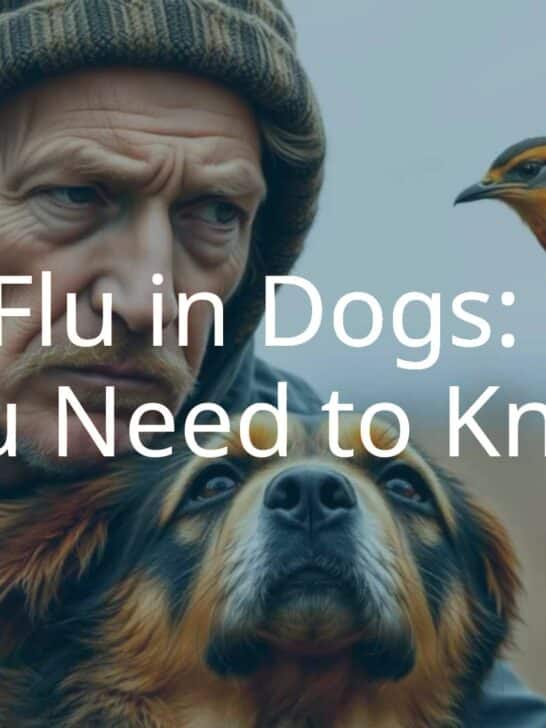German Shepherd Broken Ear Cartilage (How to Fix It!)
Ear cartilage is a crucial structure that shapes a dog’s ears, protects the ear canal, and supports ear posture and movement.
German Shepherd broken ear cartilage is typically a benign condition, and damaged cartilage will repair itself over time:
- Canine ear cartilage can break for several reasons, from injuries to genetics.
- The prognosis is usually good, and the cartilage will repair itself with proper care.
- You can take steps to prevent damaged cartilage if your German Shepherd is at risk for this type of injury.
- Broken cartilage is usually not painful, but injuries, infections, and other conditions can cause complications that require medical attention.

Reasons Why German Shepherds Can Have Broken Ear Cartilage
German Shepherds are easily identifiable thanks to their pointy ears.
Their ears have a strong cartilage structure that supports the upright ear position.
If you notice that your dog’s ears look asymmetrical or your German Shepherd has floppy ears even though they used to stand upright, your dog might have some broken cartilage.
There are different possible causes.
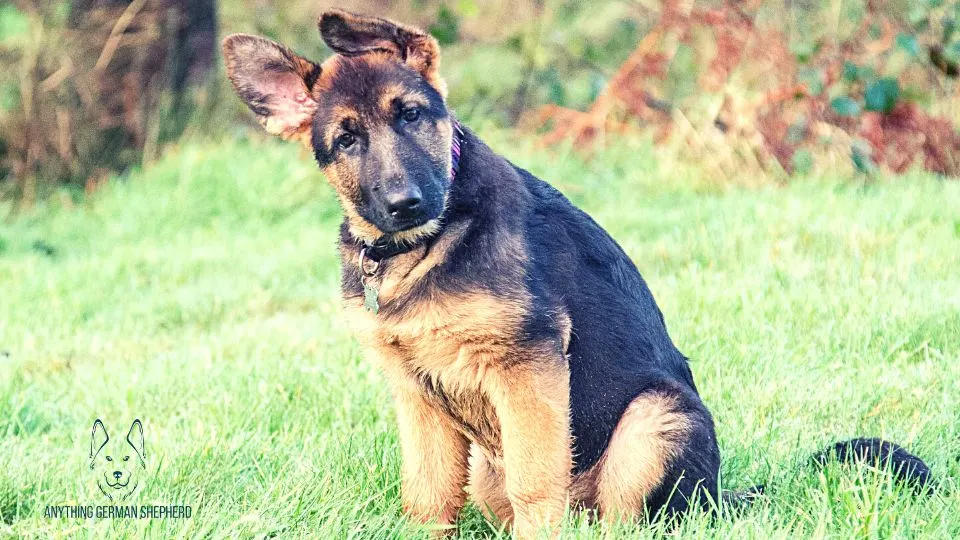
Injury
An injury can result in broken cartilage.
German Shepherd puppies can play rough and damage cartilage by biting or tugging on a playmate’s soft ears.
Injuries can also result from excessive scratching or head shaking to get rid of a foreign object.
Ear Infections
An untreated ear infection can damage surrounding tissues, including the ear cartilage.
More importantly, it can rupture the eardrum, a painful condition that results in permanent damage.
If you notice swelling, a foul odor, unusual discharge, and general discomfort, have your vet look at your German Shepherd puppies’ ears.
Trauma to the Ears
A fall or accident can cause a violent impact on the ears, resulting in broken cartilage.
Parasites
Ear mites and ticks are some of the most common parasites you can find in dog’s ears:
- Ear mites thrive in the ear canal because of the presence of wax and humidity. These parasites can cause irritation and discomfort.
- Ticks will lodge themselves in the ear canal or underneath the ear flap to suck blood. These parasites can cause pain and discomfort.
Ear parasites won’t cause direct damage to the cartilage.
But they can lead to infections or trauma as your German Shepherd shakes its head to dislodge the parasites.
Skin Allergies
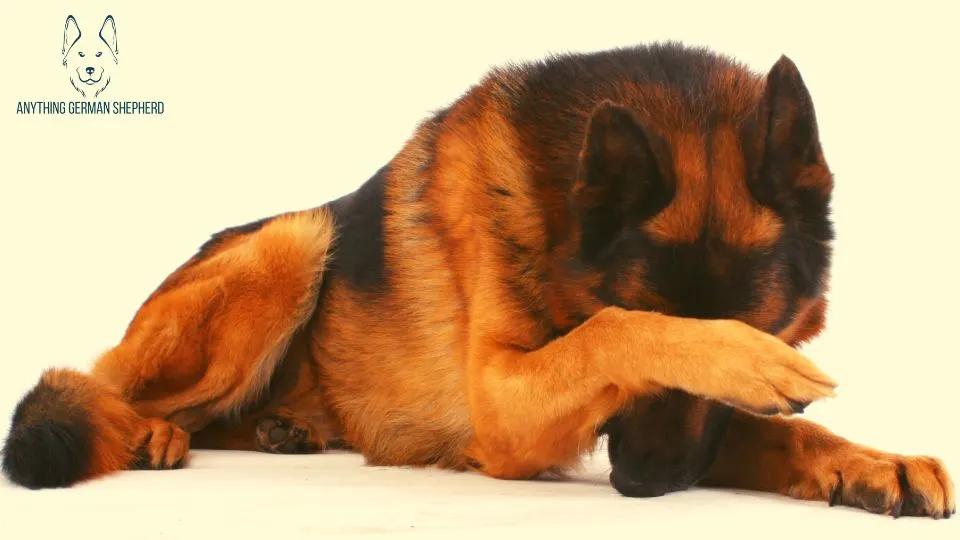
Canine skin allergies are a fairly common health problem.
Puppies’ ears are particularly sensitive because allergens like dust, pollen, or mold can become trapped in the ear flap.
Allergies can cause inflammation and itchiness, and your pet could damage its ear cartilage by scratching or excessive head shaking.
Poor Breeding
A GSP puppy is more likely to sustain cartilage injuries if they have poor genetics.
Some mutations can cause disorders that affect the cartilage and articulations.
Unfortunately, genetics can cause more serious issues with joints, hips, and even fragile bones.
Diet
A German Shepherd puppy’s diet should support the animal’s growth spurt during the first year of their lives.
Dogs need collagen, magnesium, manganese, sulfur, and hyaluronic acid to develop strong cartilage.
You might have to supplement your pet’s diet to ensure it gets all the necessary vitamins and nutrients.
Ear Cleaning
Regular ear cleaning can prevent infection and discomfort.
However, improper ear cleaning can result in lesions to the cartilage and other parts of your German Shepherd puppies’ ears.
Make sure to use a safe method when you clean your German Shepherd’s ears.
How To Fix Broken German Shepherd Ears (Make Them Stand Perfectly)
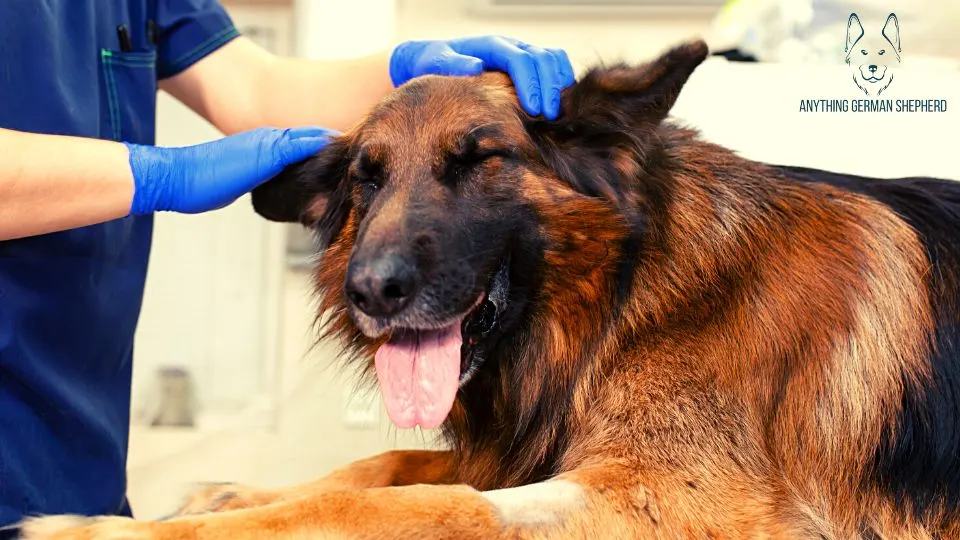
The good news is that cartilage can heal with time.
If you notice a floppy ear or asymmetrical ears, you should discuss the following treatment options with your vet.
Taping
Taping is an effective way of training your puppy’s ears to adopt an upright shape.
It’s a common practice among GSD puppy owners since these dogs don’t consistently develop erect ears.
Besides helping your puppy’s ears grow properly, taping can help broken cartilage repair itself in an upright shape.
Here are a few tips for taping your GSD’s ears safely:
- Shave the ears since tape can cause discomfort if it sticks to hair.
- Use breathable tape, like bandages or adhesive plaster.
- Choose a lightweight plastic guide or use a popsicle stick to tape the ear in an upright position.
- Be careful not to cover the ear canal opening.
- Keep your puppy away from other dogs since they might bite the tape when playing.
Video Demonstrating How To Tape Your Dog’s Ears
Massage the Ears
Dogs have extremely sensitive ears. Massaging your GSD’s ears is a great way to bond with your pet.
Ear rubs release endorphins, which can help ease pain and discomfort if your dog has an injury or infection.
Ear massages can also help with blood flow, which is crucial for healthy tissues and strong cartilage.
You should also massage your dog’s ears to help with the process of wax elimination.
Proper Ear Cleaning
Make ear cleaning a part of your grooming routine.
You should clean your dog’s ears at least once a month, but you can do it more often if you take your pet swimming.
Wipe the outer ear with a soft cloth or cotton ball before using an ear-cleaning solution and circular massaging motions to bring wax out of the ear canal.
Chew Toys
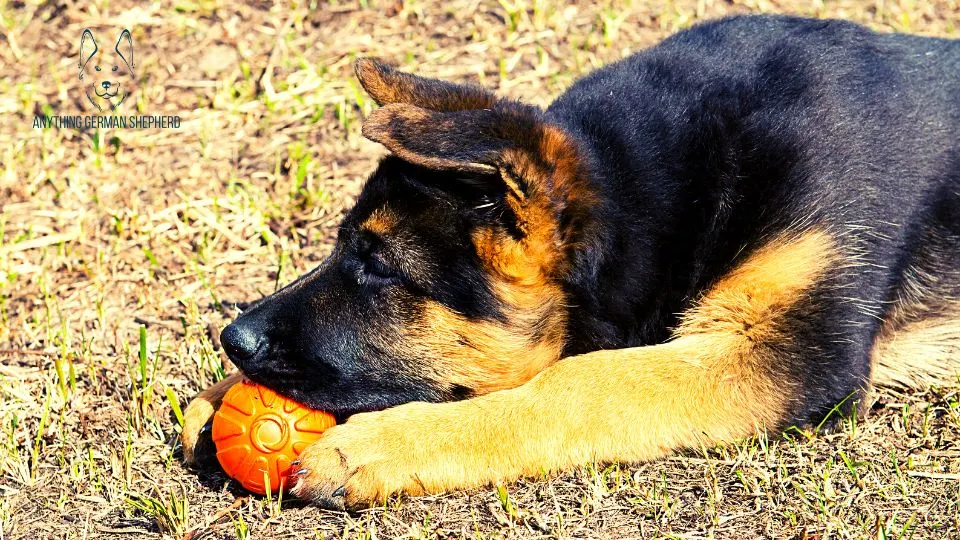
Chew toys are a great way to help your German Shepherd puppy stay active and distracted.
It can help if your dog is scratching or shaking its head due to parasites or skin allergies.
Chew toys are also an excellent option for supplementing your dog’s diet with collagen.
Note that not all chew toys contain collagen, but collagen chews are a healthy option for helping your dog rebuild damaged cartilage.
Quality Diet
A quality diet can strengthen your dog’s articulations and cartilage.
It will help prevent injuries and provide your dog with the nutrients and vitamins needed to rebuild broken ear cartilage.
GSDs are active dogs. They need a diet with high-quality proteins, grains, legumes, and vegetables.
If you feed a dry kibble diet, you should think about introducing some supplements or occasional home-cooked meals to increase your pet’s vitamin intake.
Talk to your vet about your GSD puppy’s diet to get personalized recommendations.
Positive Stimulation
Dogs are very expressive with their ears. Ears will stand erect to indicate interest, curiosity, or playfulness.
Positive stimulation will encourage your dog to use its ear muscles.
Playing games, training your puppy, or simply talking to your pet can encourage head tilt and ear movements that will help strengthen the entire ear structure.
Regularly Check for Parasites
Get into the habit of checking your dog’s ears for parasites after coming back from walks.
You can shine a flashlight down the ear canal to look for fleas and ticks.
Ear mites aren’t visible to the naked eye, which is why you should pay attention to symptoms like pawing at the ears, excessive scratching, or head shaking.
Inspecting the ear to look for signs of inflammation, missing hair, or lesions can help you spot parasites and skin allergies because the issue worsens.
Ear Protection
Ear protection is great for dogs with recurrent ear problems. During bath time, prevent water from entering the ear canal by using cotton balls.
Keeping water out of the ear canal can prevent infections and excessive head shaking to get rid of the fluid trapped in the ear canal.
Dog swim caps and headband covers are also effective ways to protect your dog’s ears.
You can use a dog swim cap when swimming or purchase a headband cover to prevent injuries if your GSD engages in rough play with other dogs.
Surgical Implants
In some cases, cartilage damage requires surgery. A vet might need to reattach the cartilage in case of a serious injury.
Surgical ear implants can also help the ear structure heal and adopt an upright shape.
If your GSD sustained a severe ear injury, schedule a vet appointment.
Your vet will determine if surgery is the best treatment option after examining the injury and using imagery if needed.
What Kind of Ears Will My German Shepherd Have?

A purebred German Shepherd should have pointed ears.
According to the breed’s official standards, the ears should look erect and open toward the front of the head.
Breeders select GSDs that meet these characteristics to produce puppies that meet these official standards.
However, some German Shepherds can develop flaws or receive genetic characteristics from a parent that isn’t a purebred dog.
A great way to tell what kind of ears your GSD puppy will have is to look at what the parents look like. Taping can also help correct ear posture.
German Shepherd Ear Shapes
As much as GSD breeders and owners would like to have dogs that adhere to breed standards, the reality is that a dog’s features depend on several factors, including:
- breeding
- nutrition
- genes
Therefore, a German Shepherd’s ears can have a variety of shapes and sizes.
At the very least, German Shepherds can end up with as many as 12 different ear shapes.
The shapes of their ears will change throughout puppyhood as well.
To see just how close to the official standard your German Shepherd’s ears are and identify any distinct characteristics or flaws that set your dog apart, check out our German Shepherd Ears Chart.
This post details 12 different types of German Shepherd ear shapes and what to expect during a GSD’s first year of life.
Can You Tell Beforehand if a GSD’s Ears Will Stand?
You won’t be able to tell if a GSD’s ears will stand until your puppy reaches four to five months.
Asking about the parents and when their ears started standing up can give you a good indicator of when you can expect this transformation to happen in your GSD puppy.
As long as you adopted a purebred German Shepherd puppy, there are no reasons to worry about whether its ears will stand up since it’s a characteristic of the breed.
When Do German Shepherds’ Ears Start To Stand Up?
German Shepherd ears can start to stand up as early as four weeks of age.
However, in most cases, this change will happen between four and five months.
Note that some factors can delay this transformation.
For instance, your dog might be under pain medication after going through a neutering or spaying procedure.
This medication can affect muscles and make it difficult for the ears to stand up.
Can Dogs Break the Cartilage in Their Ears?
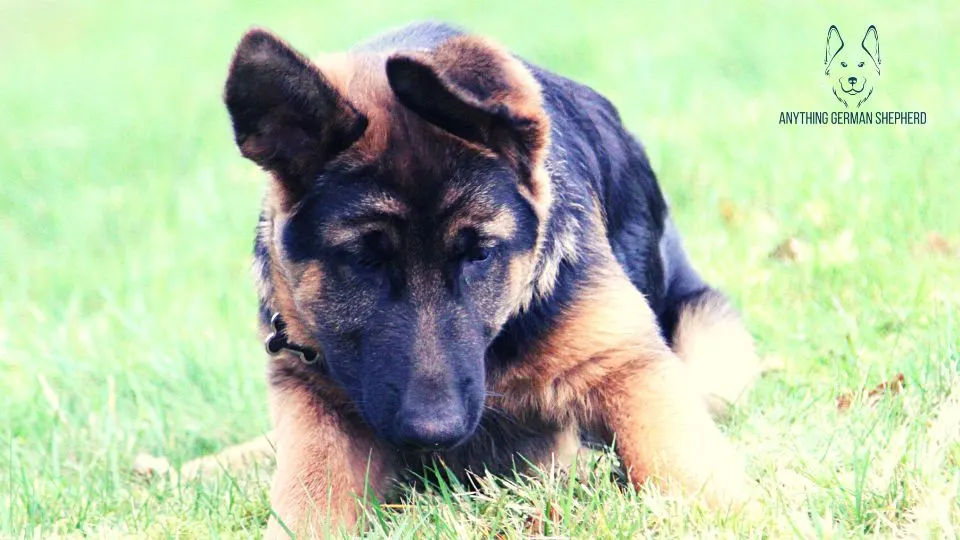
Yes, cartilage can break due to injuries, trauma, or excessive head shaking. The cartilage can also detach itself at the base of the ear structure.
The good news is that cartilage grows back. Growing new cartilage takes time, but most ear injuries don’t lead to permanent damage.
You just need to take the necessary steps to support cartilage growth.
In some cases, broken cartilage might require surgery to reattach damaged cartilage or to fix a severe lesion with sutures.
Can German Shepherds Break Their Ears?
German Shepherds can sustain ear injuries that lead to broken cartilage and other issues such as ruptured eardrums.
Broken ears often result from bite wounds from other dogs, excessive head shaking, trauma to the head, or excessive scratching.
Factors like poor genetics, parasites, or skin allergies can make your dog more likely to break its ears.
Can a Broken Dog Ear Be Fixed?
Yes, in most cases, ear injuries will heal with time. Damaged skin and cartilage will grow back, and the ear structure will return to normal.
More serious injuries like a ruptured ear drum will also heal on their own in most cases.
However, your dog might require medical care.
Antibiotics or antifungal medication will help the ear heal in the event of infection, and taping the ears can also help cartilage grow back.
How Can I Strengthen My Dog’s Ear Cartilage?
Strong ear cartilage will be less likely to break. If you have a GSD puppy or a dog who is prone to ear injuries, you can take a few steps to strengthen your pet’s ear cartilage:
- Taping your puppy’s ear to plastic guides or popsicle sticks can support the ear structure as the ears become erect.
- Ask your vet for advice if you’re unsure how to tape your dog’s ears.
- A healthy and balanced diet will provide your dog will all the vitamins and nutrients needed to grow strong cartilage.
- Choose quality dog food and consider introducing supplements or occasional home-cooked meals.
- Collagen chews can be a healthy addition to your dog’s diet. These chew toys will increase your dog’s collagen intake to support strong cartilage.
- Regular ear cleaning can prevent infections and parasites that increase the risks of ear injuries.
- Massage your dog’s ears at least once a week. It’s a great way to improve blood flow to the ear structure.
Conclusion
Broken ear cartilage is a minor health problem that German Shepherds and other breeds can run into.
It will heal over time, but there are steps you can take to support cartilage growth and prevent the issue from recurring.


















